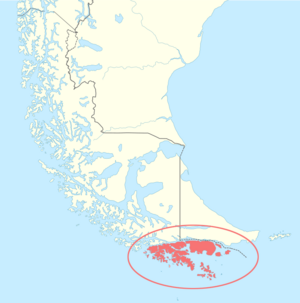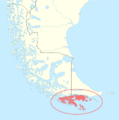Yahgan language facts for kids
Quick facts for kids Yahgan |
||||
|---|---|---|---|---|
| Yámana Háusi Kúta, Yágankuta |
||||
| Native to | Argentina and Chile | |||
| Region | Tierra del Fuego | |||
| Ethnicity | 70 Yaghan people (2012) | |||
| Extinct | 16 February 2022, with the death of Cristina Calderón | |||
| Language family | ||||
 |
||||
|
||||
The Yahgan language (also called Yámana) was spoken by the Yaghan people. They are native people from Tierra del Fuego, a region at the southern tip of South America. Yahgan is now an extinct language. This means it no longer has any native speakers.
The last native speaker, Cristina Calderón, passed away in February 2022. For a long time, Yahgan was thought to be a language isolate. This means it was not related to any other known languages. However, some experts tried to connect it to Kawésqar and Chono.
Yahgan was also spoken for a short time on Keppel Island in the Falkland Islands. This was at a missionary settlement. In recent years, there have been efforts to keep the language alive. In 2017, Chile's National Corporation of Indigenous Development started a workshop. Its goal was to create lessons in the Yahgan language. In 2019, they opened a "language nest" in Bahía Mejillones. This community is near Puerto Williams. The government also helped publish a dictionary of the Yahgan language.
Contents
Sounds of Yahgan (Phonology)
The Yahgan language had its own special sounds. Experts have studied these sounds over many years. They looked at how vowels and consonants were used.
Vowels
Yahgan had a set of vowels, similar to English.
| Front | Central | Back | |
|---|---|---|---|
| Close | i | u | |
| Mid | e | ə | o |
| Open | æ | a |
When a syllable was stressed, its vowel sound became longer. The vowel /a/ was used very often. It could sound like "uh" in unstressed parts of words.
Consonants
Yahgan also had a range of consonant sounds.
| Labial | Alveolar | Post- alveolar |
Velar | Glottal | |
|---|---|---|---|---|---|
| Nasal | m | n | |||
| Plosive | p | t | tʃ | k | ʔ |
| Fricative | f | s | ʃ | x | h |
| Rhotic | ɾ | ɻ | |||
| Approximant | l | j | w |
Word Stress
In the last known speakers, word stress was not very important. But in older forms of Yahgan, stress could change the meaning of words. Stress patterns could also shift when words were formed. This helped to tell different words apart.
How Yahgan Works (Grammar)
Yahgan grammar had some interesting features. It used many endings on words to show their role in a sentence. This is called "case marking" for nouns. Verbs also had many endings to show who was doing the action.
Sentence Structure (Syntax)
Because of all these endings, the order of words in a Yahgan sentence was not as strict. It was easier to tell who was doing what. Most sentences had the verb in the middle or at the end. Some special sentences started with the verb.
One interesting thing is how word order could change meaning. If the object of a sentence came before the verb, it might mean the object had more control. If the subject came after the verb, it might mean the subject had less control.
Grammaticalization
Grammaticalization is when regular words change over time. They become part of the grammar rules. For example, in Yahgan, verbs that meant "stand," "sit," or "lie" could also show how an action was done.
- mvni means "to stand."
- mu:tu: means "to sit."
- (w)i:a means "to lie."
These words could be added to other verbs. They would then describe the action. For example, "I stood regularly" or "You often sat." This showed how involved someone was in an activity. "Standing" meant being ready to do something else. "Sitting" meant regular involvement. "Lying" meant being deeply involved.
Pronouns
Yahgan had special words called pronouns. These words stand in for nouns, like "I," "you," or "he." The basic parts for pronouns were:
- h- for "I" or things close by.
- s- for "you" or things nearby.
- k- for "he/she/it" or things further away.
Here are some of the main pronouns:
| singular | dual (two people) | plural (many people) | |
|---|---|---|---|
| 1st person | hai (I) | hipai (we two) | haian (we all) |
| 2nd person | sa (you) | sapai (you two) | san (you all) |
| 3rd person | kvnjin (he/she/it) | kvnde:(i) or kvnde:u: (they two) | kvndaian (they all) |
| singular | plural | |
|---|---|---|
| 1st person | haia (me) | haiananima (us) |
| 2nd person | skaia (you) | sananima (you all) |
| 3rd person | kvnjima (him/her/it) | kvndaiananima (them) |
Demonstratives
Demonstratives are words like "this" or "that." They point to things. Yahgan's demonstratives were similar to its pronouns:
- hauan: 'here'
- hauanchi: 'this'
- siu:an: 'there (close)'
- siu:anchi: 'that (close)'
- kvnji: 'that (further away)'
Adjectives
Yahgan had many adjectives. These are words that describe nouns, like "dark" or "large." Many adjectives could also act as nouns or adverbs. You could turn nouns and adjectives into verbs by adding special endings. For example:
- lvmbi means 'dark' or 'black'.
- lvmbi:na means 'to be dark'.
- lvmbi:nata means 'to become dark'.
When an adjective came after a noun, it described the noun. When it came before a noun, it was part of a compound word.
- yaus-u:a means 'a lying man' (a liar).
- hu:lu:-a:nan means 'a large canoe'.
Adverbs
Adverbs describe verbs, adjectives, or other adverbs. They tell how, when, or where. Yahgan adverbs could be repeated to add emphasis. For example, chilla means 'again', and chilla chilla means 'again and again'.
Nouns
The Yahgan people lived near the sea. Their language had many words for sea birds and ocean life. But it had fewer words for land animals and plants. This shows how their environment shaped their language.
Yahgan words often focused on parts of things, not just the whole. Body parts and family relationships were described in great detail. Many nouns came from verbs.
Personal names often came from the place where someone was born. For example, a man born in Ushuaia might be called Ushuaia-njiz.
Nouns could have endings to show their role in a sentence. These endings showed if a noun was the object, or if it showed possession, location, or tools used.
Verbs
Yahgan verbs were very complex. They often combined several actions into one word. This is called "serializing" verbs. Verbs had prefixes (starts of words) and suffixes (ends of words).
- Prefixes showed who was doing the action (like "I" or "you").
- They also showed if the action was passive, causative (making something happen), or permissive (allowing something).
- Suffixes showed the time of the action (past, future) or the mood (how the action was intended).
- Verbs could also show how many times an action happened.
For example, a single Yahgan verb could mean: "We were making them take the boat during the winter a while ago."
Some verbs also showed a "reversative" meaning. For instance, ma:na means 'to lend', but ma:na:ku: means 'to borrow'.
Yahgan Alphabet
The official Yahgan alphabet used in Chile has these letters: a, æ, ch, e, ö, f, h, i, j, k, l, m, n, o, p, r, rh, s, š, t, u, w, x.
An older system by Thomas Bridges also existed. It used different ways to show long and short vowels. It also had many consonants. Over time, Bridges made changes to his system. This sometimes made it confusing for later experts.
Pronunciation Guide
This table shows how some Yahgan letters are pronounced.
| Letters A – M | A | Æ | Ch/Č | E | Ö/Ǎ | F | H | I | J/Y | K | L | M | |||||||||||||
|---|---|---|---|---|---|---|---|---|---|---|---|---|---|---|---|---|---|---|---|---|---|---|---|---|---|
| Pronounced | a | æ | tʃe | e | ə pejpi | ef | ha | i | jot | ka | el | em | |||||||||||||
| IPA sound | a | æ | tʃ | e | ə | f | h | i | j | k | l | m | |||||||||||||
| Example word | Ánan | Mæpi | Číli | Ekóle | Lǎm | Taflá | Halajélla | Ílan | Ječéla | Kuluána | Lufkié | Masákon | |||||||||||||
| IPA pronunciation | ánan | mæpi | tʃíli | ekóle | lɘm | taflá | halajélːa | ílan | jetʃéla | kuluána | lufkié | masákon | |||||||||||||
| English meaning | Canoe | Jonquil (rush daffodil) |
Wave | One | Sun | Fat | I leave you (farewell) |
Southern wind |
Dog | Grandma | Owl | Father-in-law | |||||||||||||
| Spanish meaning | Canoa | Junquillo | Ola | Uno | Sol | Gordo | Los dejo | Viento sur | Perro | Abuela | Lechuza | Suegro | Letters N – X | N | O | P | R/Rr | Rh | Ř | S | Š | T | U | W | X |
| Pronounced | en | o | pe | ar | eɹ | ɹʃ | es | ɕa | te | u | wáu | xa | |||||||||||||
| IPA sound | n | o | p | r | ɹ | ɹʃ | s | ɕ | t | u | w | x | |||||||||||||
| Example word | Nítral | Ofkís | Pušaki | Kárrpo | Wárho | Ákař | Síma | Šúša | Tapeá | Umašamái | Wilóila | Xíxa | |||||||||||||
| IPA pronunciation | nitrál | ofkís | puɕaki | kárpo | wáɹo | ákaɹʃ | síma | ɕúɕa | tapeá | umaɕamái | wilóila | xíxa | |||||||||||||
| English Meaning | Needle | Ears | Wood | Cormorant | Cave | House, hut, tent |
Water | Penguin | Mom | Barberry | Skua | Canal | |||||||||||||
| Spanish Meaning | Aguja | Orejas | Leña | Cormorán | Cueva | Casa, choza, carpa |
Agua | Pingüino | Mamá | Calafate | Salteador | Canal |
Sample Vocabulary
Here are some basic words from the Yahgan language:
- man: yagan, yámana
- woman: kíppa
- dog: yašála, ješæla
- house: tugaguu
- blood: sápa
- arm: kaméin, kamæn
- heart: sáeskin, sæskin
- moon: hanúha, hanúxa
- star: ahpérnih, apærnix
- rain: paléna
- water: síma
- fog: fóka, háoka
- sky: wákul
- fire: pušáki
- ash: áfua, axuá, ahuá
- day: maóla, mólla
- bay, inlet: ushipin
- canoe: ánan
Words from Different Dialects (Loukotka 1968)
Čestmír Loukotka (a linguist) listed some basic words from four different Yahgan dialects in 1968. This shows how the language could vary.
| gloss | Eastern Yamana |
Central Yamana |
Western Yamana |
Southern Yamana |
|---|---|---|---|---|
| tongue | lirn | lön | lana | |
| hand | yach | yosh | yöch | |
| water | shima | sima | sima | |
| moon | lam | löm | hanuxa | hauwöla |
| dog | yechela | yachöla | yeshála | ufrúku |
| fish | apamar | apörma | apöm | |
| canoe | yakenen | anan | anen | chaper |
Images for kids
See also
- Fuegians
- Mamihlapinatapai
- Selk'nam
- Alacaluf people (Kawésqar)
- Kawésqar language
- Haush language
- Fuegian languages
- In Spanish: Idioma yagán para niños


